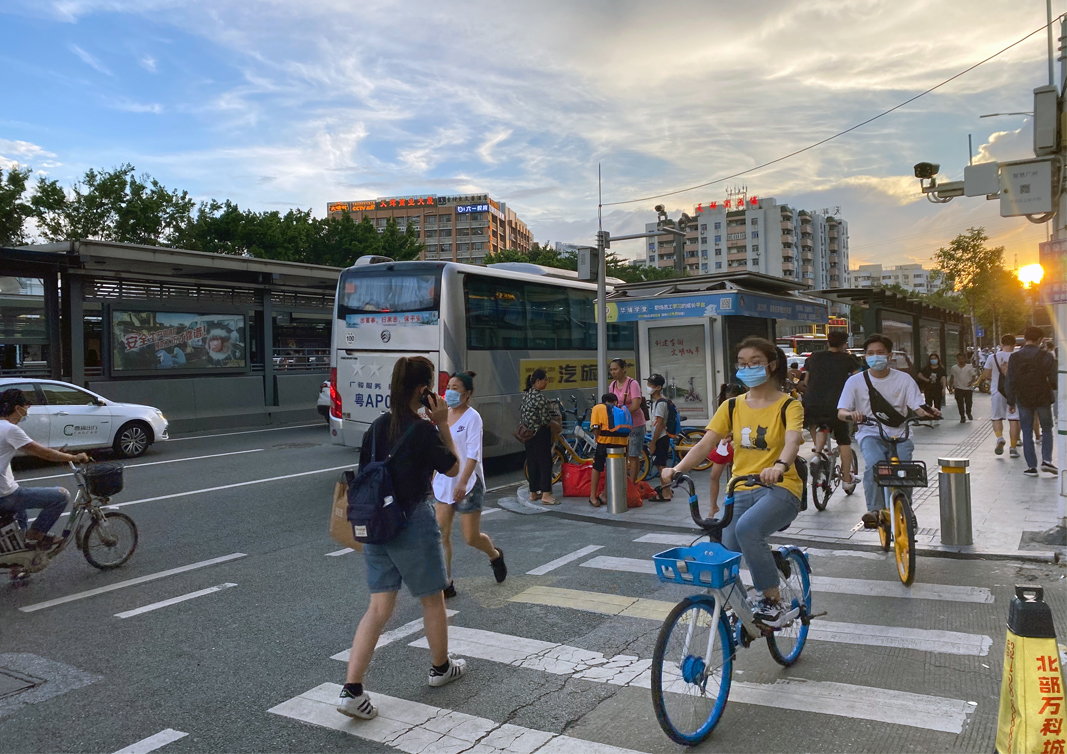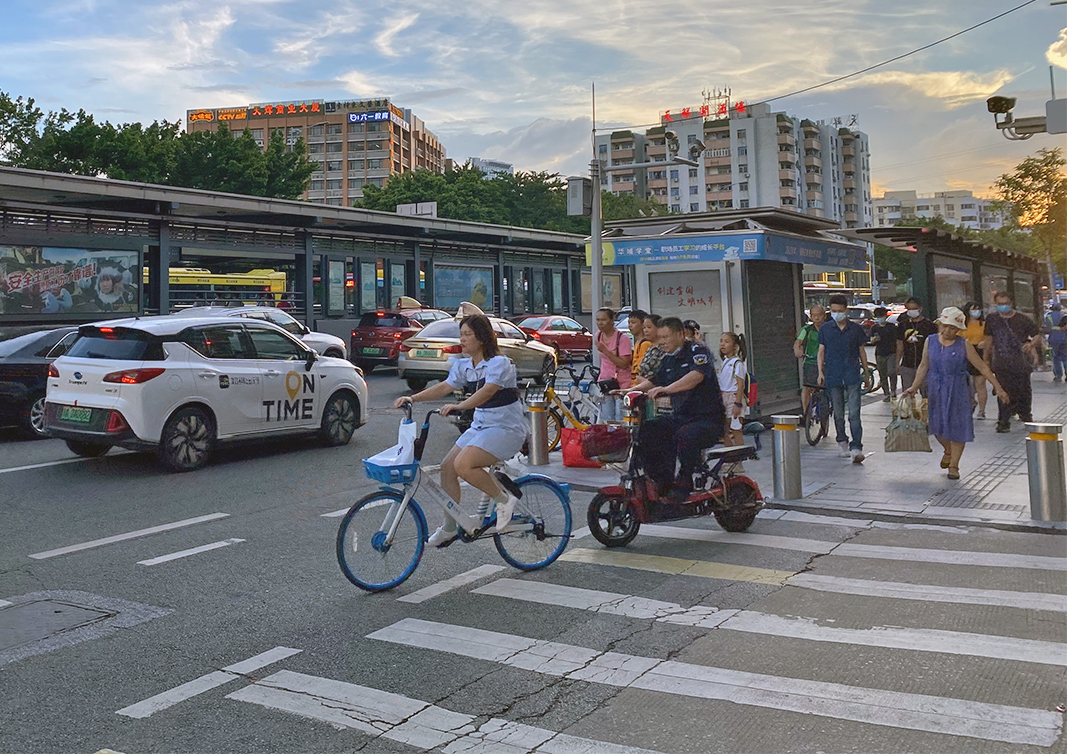Guangzhou -- 6 September 2022
In early September every year Far East Mobility counts the bicycle volumes at two locations along the Guangzhou BRT corridor for 90 minutes during the Friday morning and evening peak time periods. The 2020 count revealed a resurgence in bike sharing and continuing increase in ebikes, possibly as some people shifted from public transport during the first year impacted by Covid-19. During 2021 and 2022 the volume and composition of trips by bike did not significantly change, with ebikes accounding for more than half (51%) of all bike trips during the AM peak (at Huajing Xincheng) and 81% of all bike trips during the PM peak (at Tangxia). Bike lanes have been implemented in several locations, but these are often only ineffective painted lanes.
How long will the post-Covid boost to cycling last? The experience with the boom and bust of 2017-2018 suggests that much will depend on whether the government implements measures to promote cycling and consolidate the mode shift.
Bike sharing usage has fluctuated wildly since the dockless bike sharing systems were first introduced in mid-2016. An initial boom in bike sharing in 2017 was followed by an equally precipitous plunge in 2018 as a range of restrictions were introduced, including a ban on new bikes which prevented fleet renewal, and nearly all of the operators went out of business. By 2019 bike sharing had once again increased due to an influx of tens of thousands of new bikes from two new systems led by conglomerates Alibaba (Haluo) and Meituan (Qingji) in June. The second boom in bike sharing has taken place post-Covid in 2020, with bike sharing more than tripling from 606 per hour to 1,973 per hour at Huajing Xincheng and accounting for half of all bikes. In 2021 and 2022 the high AM peak usage of shared bikes has been retained as the bike sharing fleet has been renewed, with shared bikes accounting for 45% of bike trips.
There were no improvements to infrastructure or policies regarding bike sharing in 2020, and the increase in new bikes associated with the new operators had already occurred at the time of the 2019 counts. The increase in bike sharing usage in 2020 was therefore likely primarily due to an increase in cycling following the Covid-19 outbreak in January 2020. How long will the post-Covid boost to cycling last? The experience with the boom and bust of 2017-2018 suggests that much will depend on whether the government implements measures to promote cycling and consolidate the mode shift.
By 2022 ebikes account for more than half (51%) of all AM peak trips by bike and 81% of all bike trips during the PM peak, increasing from near zero 5 years ago when regulatory bans began to be lifted. Ebike volumes in the morning peak more than doubled between 2019 and 2020, from 778 per hour to 1,846 per hour, and increased by 22% at Tangxia in the same period. The robust and increasing demand for ebikes is less sensitive to the vagaries of bike sharing trends, as the ebikes are personally owned, but will be influenced by government policies and infrastructure provision. A ban on ebikes was lifted in 2020 but few measures have been taken to promote or provide ebike infrastructure. On the contrary various limitations on circulation, parking and usage of ebikes have been applied. As the photos below show, ebikes sometimes operate on the walkway, sometimes in the bike lanes (where they exist), and sometimes on the roadway. By 2022 there was evidence of some measures being taken to better accommodate the parking and charging of ebikes, though these are market rather than policy driven. The usage of ebikes and bikes in general appears to have plateaued by 2022, with further increases requiring as-yet unmaterialized policy and infrastructure measures to promote cycling.

 The Tangxia survey location, with bike share bikes, ebikes, taxis, long-distance coach, ride-hailing vehicles (Caocao and On Time) and BRT station. Bikes are mixed with pedestrians and vehicles on the road and walkway, with no bike lanes provided.
The Tangxia survey location, with bike share bikes, ebikes, taxis, long-distance coach, ride-hailing vehicles (Caocao and On Time) and BRT station. Bikes are mixed with pedestrians and vehicles on the road and walkway, with no bike lanes provided.
Regular bikes accounted for around 90% of bike trips in 2014, with negligible ebikes and around 10% of trips using the dock-based bike sharing system first introduced along with the Guangzhou BRT in 2010. By 2017 regular bikes had fallen to around one-third of trips and ebikes were beginning to emerge as the police relaxed the enforcement of a ban on ebikes introduced when motorcycles were banned in Guangzhou in 2007. As both bike sharing and ebikes took hold, regular personal bike usage collapsed in 2018 and now accounts for around 4% of all bike trips.
Key findings from the recent counts include:
- Bicycle usage has increased significantly after Covid-19, more than doubling during the AM peak at Huajing Xincheng and exceeding the 2017 volumes by 30%. (In the PM peak, the overall volume is still slightly below the 2017 peak which was associated with the first bike sharing boom.)
- Both bike sharing and ebike usage increased significantly in Covid-impacted 2020, especially during the AM peak where both modes approximately tripled compared to a year earlier.
- Ebikes are increasingly the dominant mode, despite operating in a gray area where usage was tolerated rather than encouraged or even legally allowed up to 2020.
- Regular bikes have declined to around 4% of cycling trips, far outweighed by bike sharing and ebikes.
- Overall bike usage appears to have plateaued during 2020-2022, with further increases likely requiring more policy and infrastructure support.
Whenever the policy, supply or demand situation allows, demand for bikes surges, suggesting significant suppressed demand that could be taken advantage of to greatly increase the bike mode share in Guangzhou. This can be seen in the initial bike sharing boom in 2017, the relaxation of the ebike ban in 2018, and the post-Covid bike sharing return in 2020. Will Guangzhou meet the opportunity by providing pro-cycling policies and especially infrastructure? There are a few sporadic signs of bike improvements being implemented, with fences providing segregated lanes in Tiyu Donglu and some other roadways, but these limited measures will have negligible impact unless rolled out on a far greater scale and supported by policy measures to facilitate and encourage ebike usage.
Cyclists at the Huajing Xincheng count location in the AM peak squeeze into the inadequate bike lane space and shaded area in September 2022.
Conditions at the count location in Tangxia in the PM peak, September 2022.
Bikes mostly use the walkway but some, primarily ebikes, also use the roadway at the Tangxia count location.
 Bikes, ebikes and pedestrians queue to cross the road at the Huajing Xincheng count location in 2020. In the background, buses queue to enter the BRT station.
Bike lanes at the survey location in Huajing Xincheng implemented as part of the BRT project in 2010. The lanes are not wide enough for the very high bicycle volumes of more than 4,000 per hour on this side of the road, leading to bikes on the walkway and roadway.
Location of counts carried out in August and September, 2014 to 2022.
Bikes, ebikes and pedestrians queue to cross the road at the Huajing Xincheng count location in 2020. In the background, buses queue to enter the BRT station.
Bike lanes at the survey location in Huajing Xincheng implemented as part of the BRT project in 2010. The lanes are not wide enough for the very high bicycle volumes of more than 4,000 per hour on this side of the road, leading to bikes on the walkway and roadway.
Location of counts carried out in August and September, 2014 to 2022.